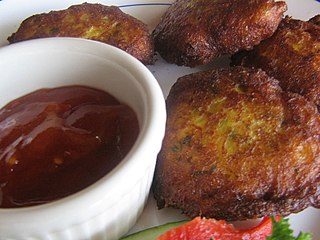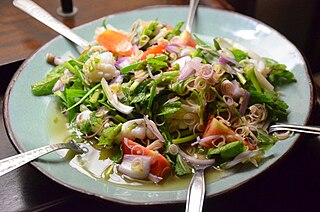Related Research Articles

Bagoóng is a Philippine condiment partially or completely made of either fermented fish (bagoóng) or krill or shrimp paste (alamáng) with salt. The fermentation process also produces fish sauce known as patís.

Shrimp paste or prawn sauce is a fermented condiment commonly used in Southeast Asian and Southern Chinese cuisines. It is primarily made from finely crushed shrimp or krill mixed with salt, and then fermented for several weeks. They are either sold in their wet form or are sun-dried and either cut into rectangular blocks or sold in bulk. It is an essential ingredient in many curries, sauces and sambal. Shrimp paste can be found in many meals in Cambodia, Indonesia, Laos, Malaysia, Myanmar, the Philippines, Singapore, Thailand, and Vietnam. It is often an ingredient in dip for fish or vegetables.

Chili sauce and chili paste are condiments prepared with chili peppers.

Thai curry is a dish in Thai cuisine made from curry paste, coconut milk or water, meat, seafood, vegetables or fruit, and herbs. Curries in Thailand mainly differ from the curries in India in their use of ingredients such as herbs and aromatic leaves over a mix of spices.

Thai fried rice is a variety of fried rice typical of central Thai cuisine. In Thai, khao means "rice" and phat means "of or relating to being stir-fried".

Pla ra, similar to padaek in Laos, is a traditional Thai seasoning produced by fermenting fish with rice bran or roasted rice flour and salt fermented in a closed container for at least six months. Fermented fish seasoning are commonly found in Cambodian, Lao, Mon, Thai and Vietnamese cuisine. Pla ra has a very strong smell, which is considered unpleasant by some people. Its flavors are salty and sour, depending on the amount of salt put in and lactic acid resulting from fermentation process.

Padaek, sometimes known as padek, or Lao fish sauce, similar to pla ra in Thailand, is a traditional Lao condiment made from pickled or fermented fish that has been cured. It is thicker and more seasoned than the fish sauce more commonly seen throughout Thailand and Vietnam, often containing chunks of fish. The fermentation takes a long time, giving padaek an aroma similar to cheeses like Époisses. Unlike other versions of fish sauce in Southeast Asia, padaek is made from freshwater fish, owing to the landlocked nature of the former kingdom of Lan Xang. Padaek is used in many dishes, most notably tam maak hoong, a spicy Lao papaya salad.

Cincalok is a Malay dish that originated in Malacca, Malaysia, consumed by Malay, Peranakan and Kristang. It can trace its origin during Portuguese occupation of Malacca. In Malacca, the shrimp is called udang geragau. This dish made up of fermented small shrimps or krill. It is usually served as a condiment together with chillis, shallots and lime juice. The shrimp in the pinkish coloured cincalok are readily identifiable and the taste is salty. Sir R. O. Winstedt has written about "Cencaluk" in Malaysia in his book "The Circumstances of Malay Life - 1909". This shrimp is available in particular season in Pantai Klebang, Limbongan, Tanjung Kling and several coastal areas.

Ngapi, formerly also spelled ngapee, nga-pee and gnapee, is a pungent paste made of either fish or shrimp in Burmese cuisine. Ngapi is usually made by fermenting fish or shrimp that is salted and ground then sundried. Like cheese, it can be distinguished based on main ingredient and regional origin. Ngapi can be distinguished by the type of fish used to make it. Ngapi can come from whole fish, from small fish or from prawns. Ngapi is a main ingredient of Lower Burmese cooking and is used as a condiment or additive in most dishes. Raw ngapi, with some exceptions, is not intended for direct consumption.

Nam phrik is a type of Thai spicy chili sauce typical of Thai cuisine. Usual ingredients for nam phrik type sauces are fresh or dry chilies, garlic, shallots, lime juice and often some kind of fish or shrimp paste. In the traditional way of preparing these sauces, the ingredients are pounded together using a mortar and pestle, with either salt or fish sauce added to taste.

Bún mắm is a fermented thick Vietnamese vermicelli soup sometimes called "Vietnamese gumbo."

Kaeng tai pla is a curry of southern Thai cuisine. Its name is derived from tai pla, a salty sauce made from fermented fish entrails, which gives the curry a strong smell and flavor.

Nam phrik long ruea is a Thailand side-dish, a kind of fried nam phrik that is normally eaten with vegetables.

Stir-fried water spinach is a common Asian vegetable dish, known by various names in Asian languages. Water spinach is stir-fried with a variety of vegetables, spices, and sometimes meats. It is commonly found throughout East, South and Southeast Asia; from Sichuan and Cantonese cuisine in China, to Indonesian, Burmese, Cambodian, Filipino, Malaysian, Singaporean, and Vietnamese cuisine in Southeast Asia; to Sri Lankan cuisine and Bengali cuisine in South Asia.

Salads that are internationally known as Thai salads with a few exceptions fall into four main preparation methods. In Thai cuisine these are called yam, tam, lap and phla. A few other dishes can also be regarded as being a salad.

Nam phrik phao is a type of Thai spicy chili sauce known as nam phrik, one of the chilli pastes used in Thai cuisine. It contains chilli peppers, shallots, garlic, fermented shrimp, tamarind, fish sauce and palm sugar.
Lentibacillus lipolyticus is a Gram-positive, aerobic, spore-forming and moderately halophilic bacterium from the genus of Lentibacillus which has been isolated from shrimp paste from the Samut Sakhon province.
Lentibacillus panjinensis is a Gram-positive, aerobic, short rod-shaped and motile bacterium from the genus of Lentibacillus which has been isolated from Shrimp paste from Panjin.
References
- 1 2 "Species: Lentibacillus kapialis". LPSN.DSMZ.de.
- 1 2 Pakdeeto, Amnat; Tanasupawat, Somboon; Thawai, Chitti; Moonmangmee, Somporn; Kudo, Takuji; Itoh, Takashi (1 February 2007). "Lentibacillus kapialis sp. nov., from fermented shrimp paste in Thailand". International Journal of Systematic and Evolutionary Microbiology. 57 (2): 364–369. doi: 10.1099/ijs.0.64315-0 . PMID 17267980.
- ↑ "Lentibacillus kapialis". www.uniprot.org.